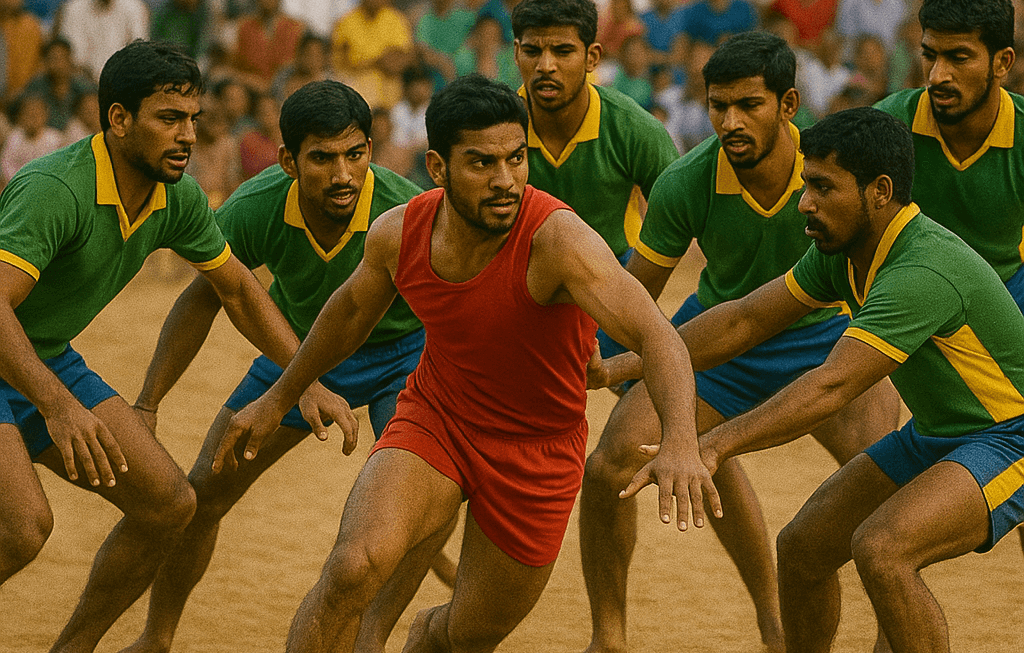Picture this: A single player crosses into enemy territory, chanting “kabaddi, kabaddi, kabaddi” in one continuous breath while seven opponents try to tackle him to the ground. No equipment. No protective gear. Just raw human strength, lightning reflexes, and lungs that could power a small village. Welcome to kabaddi — the sport that makes rugby look like a gentle afternoon stroll.
This isn’t just any game. Kabaddi represents 4,000 years of South Asian culture distilled into 40 minutes of pure athletic poetry. From the dusty villages of Punjab to the glittering arenas of Mumbai, from ancient Hindu epics to modern billion-dollar leagues, kabaddi embodies everything that makes South Asian civilization endlessly fascinating: complexity, intensity, spirituality, and an almost supernatural ability to turn the simplest concepts into profound cultural statements.
From village dust to global stages — kabaddi’s incredible journey
Kabaddi’s origin story reads like mythology because, well, it basically is mythology. Ancient texts suggest the sport emerged from military training exercises where soldiers developed breath control, physical strength, and tactical thinking simultaneously. The Mahabharata mentions similar contests where warriors demonstrated their prowess through ritualized combat that emphasized skill over brute force.
But here’s where kabaddi gets interesting from a cultural perspective: it never lost its grassroots soul despite achieving professional success. Unlike cricket, which became associated with colonial influence and elite education, kabaddi remained authentically South Asian. Village festivals still feature local kabaddi tournaments where farmers and laborers compete with the same intensity as professional league players.
The sport’s transformation from rural entertainment to televised spectacle happened remarkably fast. The Pro Kabaddi League, launched in 2014, became India’s second-most watched sports league within three years. Suddenly, players who had been earning modest livings were signing million-rupee contracts and becoming household names across the subcontinent.
This rapid professionalization created fascinating cultural tensions. Traditional kabaddi purists worried that commercial success might dilute the sport’s authentic character, while modernizers argued that global exposure would preserve kabaddi for future generations. The debate reflects broader South Asian struggles between tradition and modernity.
The village tournament ecosystem
Rural kabaddi tournaments remain the sport’s cultural heartbeat, featuring elaborate ceremonies, community feasts, and multi-generational participation that connects players with ancestral traditions. These events function as social gatherings, marriage markets, and cultural preservation mechanisms simultaneously.
Urban league sophistication
Professional kabaddi has embraced sports science, analytics, and marketing strategies that rival any global sport, creating a fascinating contrast with its humble rural origins. Team owners include Bollywood stars, tech billionaires, and international investors who view kabaddi as India’s next great cultural export.
International expansion challenges
Kabaddi’s spread beyond South Asia faces unique obstacles because the sport’s cultural significance doesn’t translate easily to societies without similar historical and spiritual contexts. Success requires adapting the game’s essence while preserving its authentic character.
Regional variations that tell the story of South Asian diversity
Every kabaddi variation tells a story about the region that created it. These aren’t just rule differences — they’re cultural fingerprints that reveal how different South Asian communities adapted the basic concept to reflect their unique values, geography, and social structures.
Punjabi kabaddi emphasizes raw physical power and aggressive tactics that mirror the region’s warrior culture and agricultural heritage. Players are typically larger, stronger, and more direct in their approach. The style reflects Punjab’s history of military conflict and its cultural celebration of physical prowess.
Bengali kabaddi, by contrast, prioritizes technique, strategy, and mental agility over pure strength. This variation mirrors Bengal’s intellectual traditions and emphasis on artistic expression. Players use more deceptive movements, complex team strategies, and psychological tactics that reflect the region’s cultural sophistication.
Tamil kabaddi incorporates unique elements that reflect South Indian philosophy and martial arts traditions. The style emphasizes fluid movement, spiritual preparation, and respect for opponents that connects to Tamil culture’s ancient emphasis on balance and harmony.
Circle kabaddi versus standard court formats
Different regions prefer different playing areas that reflect their spatial concepts and community organization. Circle kabaddi, popular in rural areas, emphasizes equality and communal participation, while rectangular courts used in professional leagues reflect modern organizational efficiency.
Seasonal variations and festival connections
Many regions have developed kabaddi variations tied to agricultural cycles, religious festivals, and community celebrations. These seasonal adaptations preserve the sport’s connection to traditional life patterns while maintaining competitive integrity.
Women’s kabaddi regional differences
Female participation in kabaddi varies dramatically across South Asian regions, with some areas embracing women’s competitions while others maintain traditional restrictions. These differences reveal ongoing negotiations between gender roles and sporting opportunities.
The spiritual and philosophical roots that make kabaddi more than sport
Kabaddi’s spiritual dimension distinguishes it from purely athletic competitions. The continuous chanting of “kabaddi” during raids isn’t just a rule — it’s a meditative practice that connects players to ancient breath control traditions found in yoga and martial arts.
The sport embodies several key Hindu philosophical concepts. The idea of one against many reflects the individual soul’s journey through life’s challenges. The requirement to return safely to one’s own half symbolizes the spiritual goal of returning to one’s true nature after worldly encounters.
Buddhist influences appear in kabaddi’s emphasis on mental discipline, strategic thinking, and respect for opponents. The sport requires players to remain calm under extreme physical pressure while making split-second tactical decisions — qualities that mirror meditation practices and mindfulness training.
The following spiritual elements make kabaddi unique among world sports:
- Breath control requirements that connect to pranayama yoga practices and ancient meditation techniques
- Individual versus collective dynamics that reflect philosophical concepts about personal responsibility within community structures
- Physical contact rules that emphasize respect and controlled aggression rather than violence or domination
- Team unity concepts that mirror family and caste obligations in traditional South Asian social organization
- Victory and defeat acceptance that reflects karmic understanding and spiritual detachment from material outcomes
- Seasonal tournament timing that connects to religious festivals and agricultural cycles across rural South Asia
These spiritual dimensions help explain why kabaddi generates such passionate fan loyalty and cultural significance beyond its entertainment value.
Modern professionalization and the billion-dollar league revolution
The Pro Kabaddi League represents one of sports history’s most successful rapid commercialization stories. Within a decade, kabaddi transformed from a predominantly rural pastime into a televised spectacle that attracts global audiences and generates hundreds of millions in revenue.
Star players like Pardeep Narwal and Rahul Chaudhari became national celebrities whose personal brands extend far beyond sports. Their success stories — typically rising from modest rural backgrounds to urban stardom — embody aspirational narratives that resonate deeply with South Asian audiences seeking social mobility.
The league’s franchise model borrowed heavily from cricket’s IPL success while adapting to kabaddi’s unique cultural context. Team names like “Bengal Warriors” and “Patna Pirates” connect to regional identities, while corporate ownership provides financial stability that enables long-term planning and player development.
International investment in kabaddi has created interesting cultural dynamics. When global sports companies began sponsoring teams and players, it legitimized kabaddi’s commercial potential while raising questions about cultural authenticity and foreign influence on traditional South Asian practices.
Player development and academy systems
Professional leagues have established sophisticated training academies that combine traditional kabaddi knowledge with modern sports science, creating new pathways for rural talent to reach elite levels while preserving the sport’s cultural essence.
Media coverage and narrative building
Television coverage of kabaddi has developed unique storytelling approaches that emphasize player backgrounds, regional pride, and cultural significance rather than just athletic performance, creating deeper emotional connections with audiences.
Sponsorship and commercial partnerships
Corporate involvement in kabaddi reflects broader economic changes in South Asia, where traditional businesses are investing in cultural preservation while modern companies seek authentic connections to local markets and communities.
Gender dynamics and women’s kabaddi breaking traditional barriers
Women’s kabaddi has become a powerful force for challenging traditional gender roles across South Asia. Female players who compete at elite levels often become symbols of women’s empowerment and social progress in conservative communities where sports participation was historically restricted.
The success of players like captain Mamta Pujari has inspired thousands of young women to pursue kabaddi despite family and social pressures. These athletes often face unique challenges: training in communities where female physical activity is discouraged, competing while managing household responsibilities, and representing their gender in high-pressure situations.
Women’s kabaddi tournaments have developed their own cultural significance, often becoming rallying points for broader discussions about women’s rights, education, and economic independence. Success in kabaddi can provide female athletes with social status and economic opportunities that might otherwise be unavailable.
The sport’s physical nature actually works in women’s favor regarding cultural acceptance. Because kabaddi emphasizes technique, intelligence, and teamwork rather than just strength, female players can demonstrate athletic excellence in ways that challenge stereotypes about women’s physical capabilities.
- Economic empowerment through prize money and sponsorships — Successful female kabaddi players can earn substantial incomes that provide financial independence and family support
- Educational opportunities via sports scholarships — Many universities now offer kabaddi scholarships that enable rural women to pursue higher education while competing athletically
- Leadership roles in sports administration — Former female players increasingly occupy coaching, management, and organizational positions that influence the sport’s development
These opportunities create positive feedback loops where successful women inspire others while building institutional support for continued female participation.
Digital age transformation and kabaddi’s global expansion strategy
Social media has revolutionized how kabaddi reaches new audiences, particularly younger demographics who might not have traditional connections to the sport. Highlight videos, player profiles, and behind-the-scenes content create emotional connections that transcend geographical and cultural boundaries.
The sport’s visual appeal translates remarkably well to digital platforms. Kabaddi’s fast pace, dramatic tackles, and emotional celebrations create shareable content that generates viral moments and attracts casual viewers who might become long-term fans.
International expansion efforts have focused on South Asian diaspora communities in countries like Canada, the United Kingdom, and Australia. These populations maintain cultural connections to kabaddi while having the economic resources to support professional leagues and development programs.
Streaming platforms have enabled global audiences to access kabaddi content, creating new revenue streams while building international fan bases. This technological reach allows the sport to grow beyond its traditional geographic boundaries while maintaining authentic cultural connections.
The challenge moving forward involves balancing global appeal with cultural authenticity. Kabaddi’s success depends on preserving the elements that make it uniquely South Asian while adapting presentation and accessibility for international audiences who lack cultural context.
Tomorrow’s kabaddi might look different from today’s version, but its cultural heart will continue beating with the same rhythm that has sustained it for millennia. The sport that began in village dust storms has evolved into a global phenomenon without losing the soul that makes it eternally fascinating.




